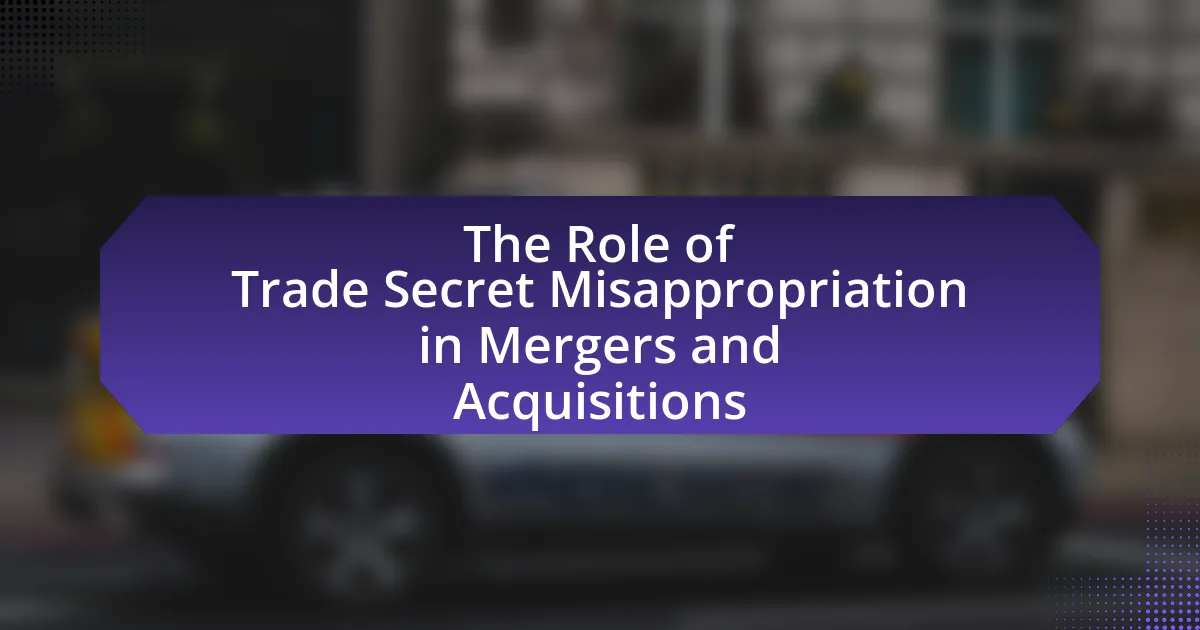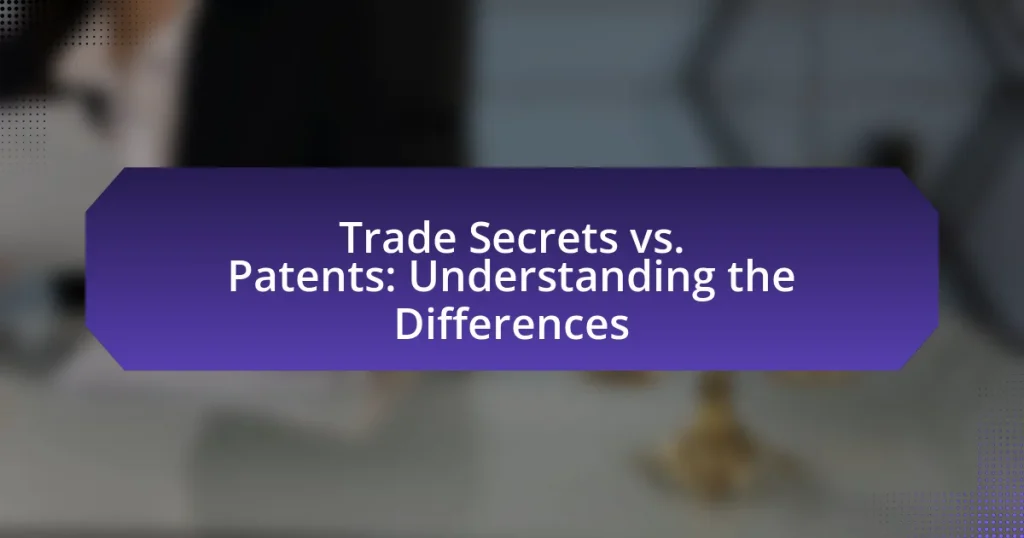Trade secret misappropriation is a significant factor in mergers and acquisitions (M&A), affecting valuation, negotiation processes, and legal risks. The article examines how misappropriation can lead to lower acquisition prices, legal disputes, and diminished competitive advantages for target companies. It outlines the legal definitions of trade secrets, the implications of misappropriation on company valuations, and the risks involved, including potential financial losses and reputational damage. Additionally, the article discusses methods of misappropriation, the role of employees, and strategies for safeguarding trade secrets during M&A transactions, emphasizing the importance of due diligence and legal protections.

What is the Role of Trade Secret Misappropriation in Mergers and Acquisitions?
Trade secret misappropriation plays a critical role in mergers and acquisitions by influencing the valuation and negotiation processes. When a company misappropriates trade secrets, it can lead to legal disputes that affect the perceived value of the target company, potentially resulting in lower acquisition prices or even deal cancellations. For instance, a study by the Economic Espionage Act indicates that trade secret theft costs U.S. businesses billions annually, highlighting the financial implications during M&A transactions. Additionally, due diligence processes often reveal trade secret vulnerabilities, prompting acquirers to reassess risks and liabilities associated with the target company. Thus, trade secret misappropriation significantly impacts strategic decisions in mergers and acquisitions.
How does trade secret misappropriation impact the M&A process?
Trade secret misappropriation significantly impacts the M&A process by introducing legal risks and potential liabilities that can deter investors and acquirers. When a company is found to have misappropriated trade secrets, it may face lawsuits, which can lead to financial penalties and damage to its reputation. For instance, a study by the Economic Espionage Act revealed that companies involved in trade secret theft often experience a decline in stock prices and investor confidence, making them less attractive for acquisition. Additionally, due diligence processes in M&A transactions become more complex, as potential buyers must assess the risk of ongoing litigation and the implications of any existing trade secret disputes. This heightened scrutiny can delay negotiations and increase costs, ultimately affecting the overall valuation and feasibility of the merger or acquisition.
What are the legal definitions of trade secrets in the context of M&A?
Trade secrets are defined legally as information that derives independent economic value from not being generally known or readily ascertainable by others who can obtain economic value from its disclosure or use. In the context of mergers and acquisitions (M&A), trade secrets encompass proprietary formulas, practices, processes, designs, instruments, or patterns that provide a competitive advantage. The Uniform Trade Secrets Act (UTSA) and the Defend Trade Secrets Act (DTSA) in the United States provide frameworks for the protection of trade secrets, emphasizing the necessity of reasonable efforts to maintain their secrecy. Misappropriation of trade secrets during M&A can lead to legal disputes, as companies must ensure that sensitive information is safeguarded to prevent unauthorized use or disclosure, which could undermine the value of the transaction.
How can misappropriation of trade secrets affect valuation during M&A?
Misappropriation of trade secrets can significantly reduce a company’s valuation during mergers and acquisitions (M&A) by introducing legal risks and diminishing competitive advantage. When trade secrets are compromised, potential acquirers may perceive the target company as less valuable due to the uncertainty surrounding its proprietary information and the potential for litigation. For instance, a study by the Economic Espionage Act indicates that companies facing trade secret theft can experience valuation drops of up to 20% due to lost market position and increased operational risks. Furthermore, the presence of ongoing legal disputes related to trade secrets can deter buyers, leading to lower offers or even withdrawal from negotiations.
Why is understanding trade secret misappropriation crucial for companies involved in M&A?
Understanding trade secret misappropriation is crucial for companies involved in M&A because it directly impacts the valuation, legal risks, and competitive advantage of the entities involved. Companies must assess the potential for trade secret theft during the due diligence process to avoid costly litigation and reputational damage. For instance, a study by the Economic Espionage Act indicates that trade secret theft costs U.S. businesses over $300 billion annually, highlighting the financial implications of misappropriation. Additionally, understanding these risks allows companies to implement protective measures, ensuring that proprietary information remains secure during and after the transaction.
What risks do companies face if trade secrets are misappropriated during M&A?
Companies face significant risks if trade secrets are misappropriated during mergers and acquisitions, including financial loss, competitive disadvantage, and legal repercussions. Financially, the loss of proprietary information can lead to decreased market share and revenue, as competitors may exploit the stolen trade secrets to gain an edge. A competitive disadvantage arises when the misappropriation allows rivals to replicate unique products or services, undermining the original company’s market position. Legally, companies may incur substantial costs from litigation to recover misappropriated secrets or to defend against claims, which can also damage their reputation and stakeholder trust. According to the Economic Espionage Act, trade secret theft can result in criminal penalties, further compounding the risks faced by companies involved in M&A activities.
How can trade secret misappropriation lead to post-merger disputes?
Trade secret misappropriation can lead to post-merger disputes by creating legal liabilities and undermining trust between merging entities. When one company improperly uses or discloses the trade secrets of another during or after a merger, it can result in lawsuits, financial penalties, and reputational damage. For instance, a study by the Economic Espionage Act indicates that trade secret theft costs U.S. businesses billions annually, highlighting the significant risks involved. These disputes can complicate integration efforts, disrupt operations, and lead to prolonged litigation, ultimately affecting the merger’s success and value.

What are the common methods of trade secret misappropriation in M&A?
Common methods of trade secret misappropriation in mergers and acquisitions (M&A) include unauthorized access to confidential information, employee poaching, and improper disclosure during due diligence. Unauthorized access occurs when individuals exploit weaknesses in security systems to obtain sensitive data without permission. Employee poaching involves recruiting key personnel who possess proprietary knowledge, thereby transferring trade secrets to competitors. Improper disclosure during due diligence happens when parties share sensitive information without adequate safeguards, increasing the risk of leaks. These methods highlight the vulnerabilities in M&A processes, emphasizing the need for robust protective measures to safeguard trade secrets.
How do employees contribute to trade secret misappropriation during M&A?
Employees contribute to trade secret misappropriation during mergers and acquisitions (M&A) by inadvertently or intentionally disclosing sensitive information to unauthorized parties. This can occur through various means, such as sharing proprietary data during negotiations, failing to adhere to confidentiality agreements, or being recruited by competing firms post-M&A. Research indicates that approximately 60% of trade secret theft cases involve employees, highlighting the significant risk posed by insider actions. Furthermore, during M&A, employees may be motivated by uncertainty about their job security, leading them to leak information to gain leverage or secure employment elsewhere.
What role does insider information play in trade secret theft?
Insider information is crucial in trade secret theft as it provides individuals with unauthorized access to confidential business data, enabling them to exploit this information for competitive advantage. This access often occurs when employees or associates misuse their positions to gather sensitive information, such as proprietary formulas, customer lists, or strategic plans. According to the Economic Espionage Act of 1996, the theft of trade secrets can lead to significant financial losses for companies, highlighting the importance of safeguarding insider information. In mergers and acquisitions, the misuse of insider information can distort valuations and lead to unfair competitive practices, further emphasizing its role in trade secret theft.
How can companies prevent employee-related misappropriation during M&A?
Companies can prevent employee-related misappropriation during mergers and acquisitions by implementing robust security measures and conducting thorough due diligence. Establishing clear policies regarding the handling of sensitive information, including trade secrets, is essential. Training employees on these policies and the legal implications of misappropriation can further mitigate risks. Additionally, conducting background checks on key personnel and monitoring access to confidential data can help identify potential threats. Research indicates that organizations with comprehensive information security programs experience significantly lower instances of data breaches, reinforcing the importance of proactive measures in safeguarding intellectual property during M&A activities.
What external factors can lead to trade secret misappropriation in M&A?
External factors that can lead to trade secret misappropriation in mergers and acquisitions (M&A) include competitive pressures, inadequate due diligence, and regulatory environments. Competitive pressures can drive companies to unlawfully acquire sensitive information to gain an advantage, as seen in cases where firms engage in espionage or unethical practices. Inadequate due diligence during the M&A process may result in insufficient protection of trade secrets, allowing for unintentional disclosure or theft. Additionally, regulatory environments that lack stringent enforcement of trade secret protections can create opportunities for misappropriation, as companies may exploit loopholes or insufficient legal frameworks to access proprietary information without repercussions.
How do competitors exploit trade secrets during M&A transactions?
Competitors exploit trade secrets during M&A transactions by gaining unauthorized access to sensitive information that can provide a competitive advantage. This exploitation often occurs through due diligence processes, where competitors may scrutinize confidential documents and data, sometimes under the guise of legitimate interest. For instance, a study by the Economic Espionage Act indicates that trade secret theft can lead to significant financial losses, with estimates suggesting that U.S. companies lose up to $600 billion annually due to such misappropriation. Additionally, competitors may leverage insider knowledge obtained during negotiations to undermine the target company’s market position or to enhance their own strategic initiatives.
What measures can be taken to safeguard trade secrets from external threats?
To safeguard trade secrets from external threats, organizations should implement robust security measures, including legal protections, physical security, and employee training. Legal protections involve non-disclosure agreements (NDAs) and confidentiality clauses in contracts, which legally bind employees and partners to protect sensitive information. Physical security measures include restricted access to facilities where trade secrets are stored, surveillance systems, and secure storage solutions. Employee training programs educate staff on the importance of trade secrets and the protocols for handling sensitive information, reducing the risk of unintentional disclosures. These measures collectively create a comprehensive strategy to protect trade secrets from external threats, as evidenced by the increasing adoption of such practices in industries where intellectual property is critical for competitive advantage.

What are the legal implications of trade secret misappropriation in M&A?
Trade secret misappropriation in mergers and acquisitions (M&A) can lead to significant legal implications, including civil liability, criminal penalties, and potential injunctions against the use of the misappropriated information. Companies involved in M&A must ensure that they do not unlawfully acquire or use trade secrets from competitors, as this can result in lawsuits under the Uniform Trade Secrets Act or the Defend Trade Secrets Act, which provide remedies for the misappropriation of trade secrets. For instance, a company found guilty of misappropriation may face damages that include actual losses, unjust enrichment, and in some cases, punitive damages. Additionally, the acquiring company may be subject to regulatory scrutiny and reputational harm, which can affect future business operations and relationships.
What laws govern trade secret protection in the context of M&A?
Trade secret protection in the context of mergers and acquisitions (M&A) is primarily governed by the Uniform Trade Secrets Act (UTSA) and the Defend Trade Secrets Act (DTSA) in the United States. The UTSA, adopted by most states, provides a framework for the definition and protection of trade secrets, while the DTSA offers federal protection, allowing trade secret owners to file civil lawsuits in federal court for misappropriation. These laws establish the criteria for what constitutes a trade secret and the legal remedies available for misappropriation, which are crucial during M&A transactions where sensitive information is often shared.
How do state and federal laws differ in their approach to trade secrets?
State and federal laws differ in their approach to trade secrets primarily in terms of the legal frameworks and protections they provide. The federal law governing trade secrets is the Defend Trade Secrets Act (DTSA) of 2016, which allows for civil lawsuits in federal court and provides a uniform standard for what constitutes a trade secret. In contrast, state laws, such as the Uniform Trade Secrets Act (UTSA), vary by jurisdiction and may have different definitions, remedies, and procedures for trade secret misappropriation. For example, while the DTSA allows for ex parte seizure of property to prevent further misappropriation, not all states provide this remedy under their laws. This divergence can lead to inconsistencies in enforcement and protection of trade secrets across different states.
What are the potential penalties for trade secret misappropriation in M&A?
Potential penalties for trade secret misappropriation in mergers and acquisitions (M&A) can include civil damages, criminal penalties, and injunctive relief. Civil damages may involve compensatory damages for actual losses and, in some cases, punitive damages that can be awarded if the misappropriation is found to be willful and malicious. Criminal penalties can lead to fines and imprisonment for individuals involved in the misappropriation, as outlined in the Defend Trade Secrets Act of 2016, which allows for criminal prosecution. Additionally, courts may issue injunctions to prevent further use or disclosure of the misappropriated trade secrets, thereby protecting the interests of the aggrieved party.
How can companies legally protect their trade secrets during M&A?
Companies can legally protect their trade secrets during mergers and acquisitions (M&A) by implementing non-disclosure agreements (NDAs) and conducting thorough due diligence. NDAs create a legal obligation for parties involved to keep sensitive information confidential, thereby reducing the risk of misappropriation. Additionally, conducting due diligence allows companies to identify and assess the value of their trade secrets, ensuring that appropriate measures are in place to safeguard them. According to the Uniform Trade Secrets Act, trade secrets are protected as long as reasonable efforts are made to maintain their secrecy, which reinforces the importance of these legal frameworks during M&A transactions.
What best practices should be implemented to safeguard trade secrets?
To safeguard trade secrets, organizations should implement strict access controls, confidentiality agreements, and employee training programs. Access controls limit who can view sensitive information, ensuring that only authorized personnel have access. Confidentiality agreements legally bind employees and partners to protect proprietary information, reducing the risk of unauthorized disclosure. Employee training programs educate staff on the importance of trade secrets and the protocols for handling sensitive information, fostering a culture of security. According to the Economic Espionage Act of 1996, misappropriation of trade secrets can lead to severe legal consequences, reinforcing the need for these best practices.
How can confidentiality agreements be effectively used in M&A?
Confidentiality agreements can be effectively used in M&A by ensuring that sensitive information shared during the due diligence process is protected from unauthorized disclosure. These agreements create a legal obligation for parties to maintain confidentiality, thereby safeguarding trade secrets and proprietary information that could be misappropriated. For instance, a study by the Harvard Law School Forum on Corporate Governance highlights that confidentiality agreements are crucial in preventing competitive harm and maintaining the integrity of negotiations, as they outline the scope of information covered and the consequences of breaches. This legal framework not only fosters trust between parties but also mitigates risks associated with trade secret misappropriation during mergers and acquisitions.
What strategies can companies adopt to mitigate risks associated with trade secret misappropriation in M&A?
Companies can adopt several strategies to mitigate risks associated with trade secret misappropriation in mergers and acquisitions (M&A). Implementing robust confidentiality agreements is essential, as these legally bind parties to protect sensitive information. Conducting thorough due diligence helps identify potential risks and assess the trade secret landscape of the target company. Additionally, companies should establish clear internal protocols for handling trade secrets, including employee training on confidentiality and the importance of safeguarding proprietary information. Utilizing non-disclosure agreements (NDAs) during negotiations further reinforces the commitment to protecting trade secrets. According to a study by the Economic Espionage Act, trade secret theft costs U.S. businesses billions annually, highlighting the necessity of these strategies to safeguard valuable intellectual property during M&A transactions.
How can due diligence processes be enhanced to identify trade secret risks?
Due diligence processes can be enhanced to identify trade secret risks by implementing comprehensive assessments of intellectual property management practices and conducting thorough interviews with key personnel. These enhancements allow organizations to uncover potential vulnerabilities related to trade secrets, as evidenced by a study from the American Bar Association, which highlights that 70% of trade secret thefts occur due to inadequate internal controls. Additionally, integrating advanced data analytics tools can help identify unusual patterns in data access and usage, further mitigating risks associated with trade secret misappropriation during mergers and acquisitions.
What role does employee training play in protecting trade secrets during M&A?
Employee training plays a critical role in protecting trade secrets during mergers and acquisitions (M&A) by ensuring that employees understand the importance of confidentiality and the legal implications of disclosing sensitive information. Effective training programs educate employees on the specific trade secrets of the company, the potential risks associated with their misappropriation, and the protocols for handling confidential information. According to a study by the Association for Corporate Counsel, organizations that implement comprehensive training on trade secret protection reduce the risk of information leaks by up to 40%. This demonstrates that well-informed employees are less likely to inadvertently disclose trade secrets, thereby safeguarding the company’s competitive advantage during the M&A process.



